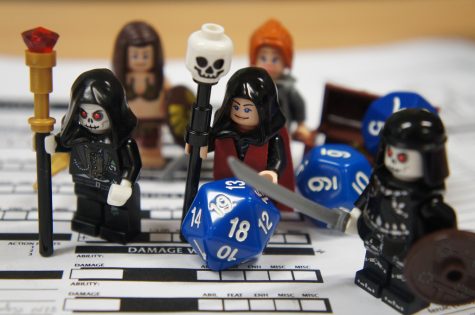Beyond the surface: more than dragon daydreams
 Creative Commons
Creative Commons
Every week The Shield will showcase students and their hidden hobbies and talents. This week Austin Steele and Kimberly Rocca spoke about their love for Dungeons and Dragons.
Austin Steele is also known as Dragonborn.
The sophomore computer science major is an avid player of Dungeons and Dragons.
Dungeons and Dragons is a fantasy tabletop roleplaying game first published in 1997. It mimics wargaming and each player receives a unique character for imaginary fantasy adventures and quests.
The leader of the game, also known as Dungeon Master, serves as a narrator and referee, keeping track of the setting and the roles. Essentially, the game follows players roleplaying as their characters that engage in battles, solve dilemmas and search for treasure.
The players are able to gain experience points to raise their levels and ranks and obtain greater powers.
“It’s kind of like a walking dragon,” Steele said. “My character was a farmer that one day got a sense for adventure and left home to explore the world he lives in.”
Steele became interested in Dungeons and Dragons when he overheard kids talking about it at a band practice in middle school.
“To me, it’s like the same as playing a video game, but instead of someone giving you a character, you actually get to make a super awesome character and pick their traits and how they act,” Steele said.
For players such as Steele, being able to create characters and choose their traits and histories allows players to delve into their own creativities and thinking processes. It allows them to express themselves or certain ideals through imaginative figures.
Players start by developing and creating their characters. They choose the race, status, abilities and many other customizations. Once the rules of the game are established, each player rolls the die to determine the success or failure of their character’s tasks. They can mutter phrases of good fortune into their die before rolling to see what numbers describe their combat, explorations and interactions.
Kimberly Rocca first became interested in the role-playing game when she heard a few friends talking about it.
Being a lover of fantasy, the sophomore marketing major couldn’t resist learning about the game.
“It sounded super fun and interesting,” Rocca said. “The characters are really cool.”
layers can select characters, to create and shape to their own whims, in Dungeons and Dragons, this includes knights, rogues, clerics, wizards, fighters and rangers. Players can also choose more unconventional characters such as sharpshooters and brawny rogues who participate in hand-to-hand combat.
There are also different races players can choose to inspire their characters, such as humans, elves, dwarves, halflings, gnomes, half-orcs, tieflings and dragonborns.
Rocca’s character is a rogue.
“I have super good luck with rolls when it comes to serious stuff,” she said.
However, sometimes disasters and amusing instances happen in the game.
Rocca recalls a time when she was playing with friends and started to mess around during an important battle. ‘I was like ‘oh ha ha I’ll just flip over this portal instead of walking around it like a normal person’ and then I fell into a realm with zombies,’” she said.
Rocca and Steele play Dungeons and Dragons at least once a week with a circle of friends. It allows them to spend time with friends who share common interests and to practice character building and the planning of strategies and tactics.
“The concept of being able to create something and build off of it from campaigns is amazing,” Rocca said. “It’s super fun to do a character build. It’s really interesting.”

